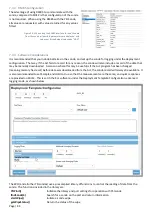
Page | 44
7.3.3
RS485 Configuration
The advantage of using RS485 to communicate with the
sonde, compared to SDI12 is that configuration of the sonde
is not required. When using the RS485 with the YSI Sonde,
all values are requested, with values returned for any values
fitted.
7.3.4
Software Considerations
It is recommended that you include batteries in the sonde, and set up the sonde for logging under the deployment
configuration. That way, if the Ai1 fails to record for any reason, the sonde will also include a record of the data that
may be manually downloaded. A scenario where this may be useful is if the Ai1 program has been changed
(meaning memory has reset) before data was downloaded from the Ai1, the sonde record will always be available. It
is also recommended to set Sample and Hold to true so that the measurements are the same, and quick responses
are provided on SDI12. This is set in the Kor software, under the Deployment Template Configuration, advanced
logging mode, as shown below
The EXO (and all other YSI sondes) use a precompiled library of functions to control the reading of data from the
sonde. The functions included in the library are:
YSIPInit()
Initialize the library and port settings for operation with YSI sonde
findSonde(3)
Search for a sonde on the port and return information
startWipe()
Initiate a sonde wipe
getWipeStatus()
Return the status of the wipe
Figure 24 - When using the RS485 interface to read the data
from the sonde, all possible parameters are displayed, with
values not fitted being displayed as “NAN”.
















































